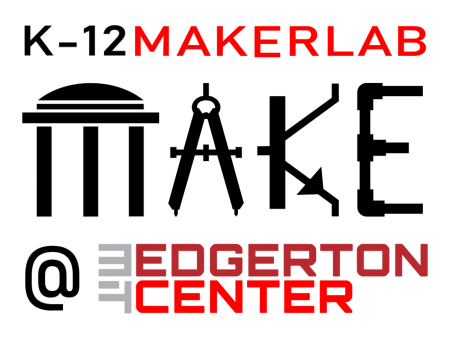Introduction: Math Battleship
Sharpen your math skills by playing Math Battleship! We designed our own version of the classic battleship game to feature algebraic functions. Use it with math functions ranging from slope-intercept lines to parabolas to hyperbolas. Try functions with operators such as inequalities or absolute value for a really challenging game.
This Instructable teaches you how to build your own basic game set, how to play the game, and provides ideas on customizing the game. If you are a math teacher, have each student make their own and pair up with a classmate for an engaging math activity. Have fun playing the and building your math skills!
This game was created by the K12Maker team at the MIT Edgerton Center. It was designed by MIT students Alexandra Lee, Johan Maysonet, and Bella Xu, and the Instructable written by Bella Xu and Diane Brancazio
Supplies
For this design you will need:
- Computer with access to graphics software
- Laser Cutter
- 1/8" birch plywood and/or 1/8" acrylic sheet
- 3D Printer
- Hot glue
Step 1: Design and Create Your Game Board
Finished Game Inventory (1 set):
- 1 - laser cut 9.5"x8" bottom board
- 1 - laser cut 9.5"x8" top board
- 2 - 3D printed board joiners (left and right)
- 10 - laser cut ships
- 20 - laser cut acrylic "hit" pegs
- 30 - laser cut acrylic "miss" pegs
BASIC BUILD: The basic game setup consists of two 9.5 inch by 8 inch boards, one for the bottom and one for the top. Each board contains an 11 by 11 grid of 1/8" square holes. The centers of the holes are located 5/8" apart from each other. As shown here, the holes represent lattice points in the first quadrant of the Cartesian coordinate system. By labeling the axes differently, you can create a game with points in any quadrant, or in all 4 quadrants.
The grid and the labels on the X and Y axes were created using the score setting on the laser cutter.
Files for cutting and scoring the basic game board are attached. We designed the game board using a free online graphics app called Gravit Designer. That file is linked here. You can download SVG files easily from Gravit.
Feel free to use & modify these files or create your own.
CUSTOMIZE: The basic game board has about 1.25" of blank space to the left and to the right of the grid. The top board also has about an inch of space to the top of the grid. This blank space is made so you can customize your boards. Sample customizations are shown. You can use the laser cutter or handwrite designs, your name, or mathematical graphs to help you while playing the game.
Have a friend make another set to play together!
Step 2: Join the Two Boards
To join the two boards, we designed 3D printable connectors that hold the top board and the bottom board in place. In order for the bottom board to not slide out of the holder, we added a 1/8" square hole on both sides of the bottom board, centered at 1/2" from the top edge and 3/16" from the outer edges. The board is then fastened to the connector with one of the hit and miss pegs. Attached are the files for 3D printing the holders.
To improve the fit of the bottom board in the connector, we added blobs of hot glue on the underside of the bottom board, at the front corners. This also allows the ships and miss pegs to stay in place more easily on the bottom board as well as keeps the game from sliding on a smooth table.
Other ways to join the boards without a 3D printer could be to use tape or ribbons from the sides of the bottom board to the top board . Use your creativity!
Step 3: Make the Ships
Each ship consists of two 1/2" diameter circles with a 1/8" square hole in the middle, and a 3/8" by 1/8" rectangular stem. For 10 ships you'll need 20 discs and 10 stems. Laser cut all pieces out of birch wood. If your laser cutter leaves a wide kerf, make the pegs a bit wider, such as .140" instead of .125"
To assemble the ships, first glue the stem into the hole of one disc, making it flush with the bottom surface of the disc. Then glue the other disc on top of the flush surface, leaving two stacked discs with a hole on the top and a stem on the bottom. This design allows us to place the stem of the ships into our board securely, and the top hole allows us to place hit pegs into the ship itself. You can use hot glue, wood glue or white glue for this. If you use hot glue, be careful not to block the hole for the peg. With white or wood glue, place the pieces on waxed paper and leave time to dry
The ships don't have to be round, you can make the discs any shape you want as long as you keep the 1/8" hole for the hit peg.
Files for the ship disks and peg are attached.
The Gravit Designer file for the ship pieces and the pegs is linked here. You can download SVG files easily from Gravit.
Step 4: Design and Make the Marking Pegs
We need two types of pegs in this game: a "hit" peg, to mark your ships as hit and to mark where you hit your opponents ships, and a "miss" peg to mark a guess that didn't hit your opponents ship. Both types of pegs consist of a shape on top of a 1/8" wide x 1/4" tall stem. You can design the top shape to be whatever you want, keeping the max width to be roughly 1/4".
To differentiate between hit pegs and miss pegs, you can design different top shapes or have them be different colors. In our example game, the hit pegs have a star on top and are printed on red acrylic, while miss pegs have a circle and are printed on light blue acrylic. You can also laser cut these from birch and color them with paint or markers.
After designing your pegs, to cut 20 hit pegs and 30 miss pegs. If you are modifying the game to have a different number of ships, be sure your number of hit pegs stays twice the number of ships, and have plenty of miss pegs as well.
Files for our hit and miss pegs are attached.
The Gravit Designer file for the ship pieces and the pegs is linked here. You can download SVG files easily from Gravit.
Attachments
Step 5: Play the Game!
This game is designed to be easy to modifiy. You make rules that maximize your fun & learning. We have some guidelines and ideas to help you design your game rules. As in the orignal game, the winner can be the first to sink all of the opponent’s ships. Alternatively, the winner could be the first one to identify the function your opponent plotted with their ships. Original Battleship Instructions are found here: https://www.hasbro.com/common/instruct/Battleship.
BASIC PLAY
Collect all materials:
- 10 ships
- Pegs: 20 hit marker pegs, 30 miss marker pegs
- Grid boards
Agree on the rules
- Set Rules for your game - the types of functions you can use, how to win (correct guess at any time, loss for an incorrect guess, guess after a certain number of turns, etc)
Play
- Opponent sit facing each other, with the backboards back-to-back so neither can see the other’s grid.
- Each player chooses a function that meets agreed upon criteria and places their ships on integer coordinate points that fit the function
- Play proceeds as in the classic Battleship game with players making guesses in turn. The opponent indicates whether the guess was a “hit” or “miss”. Hits and misses are marked by the player on their top board and the opponent on their bottom board.
- Whether a hit or miss, players alternate turns
- Between turn, players "do the math" and determine their opponent's function from the points they have hit
End the game
The game can end as you decide. Here are some options:
- One opponent has hit all the opponents ship
- One opponent has identified the function their opponent plotted
- Both opponents have identified the plotted functions
- Both opponents have had a given number of turns and they each try to idenifty the plotted functions
ALTERNATE VARIATIONS
- Easy:
- Objective is to determine the shape of the graph. Opponents guess coordinates like in classic battleship. Ships are placed roughly in the shape of functions (e.g. linear, exponential, parabola, etc.)
- Medium:
- Objective is to determine the linear mathematical function that falls on your opponents points
- Hard:
- Objective is to determine a nonlinear function that falls on your opponents points (parabola, absolute value, circular, etc.)
Step 6: Customize Your Game Even More
In addition to changeing the rules, you can redesign the gameboards. Here are some ideas:
- Change the grid numbers to represent other locations in the coordinate system
- Change the size of the board to make a larger (and harder) game
- Use a circular arrangement to represent polar coordinates
- Design your own method of joining the top board and bottom board in a foldable manner
- Design your own game rules for more than 2 players
Step 7: Enjoy and Share!
Thanks for trying our Instructable!
We hope you had fun creating random daisies with Tinkercad Codeblocks! What did you make? We want to see! Share your Makes here, or drop us a message. If you did this activity with K-12 students, let us know what grade level and content area.
Join our mailing list to get the latest news, tips, and insights from the K-12 Maker Lab!
Visit our website k12maker.mit.edu to get free Maker resources for K-12 teachers!
- Starter projects - simple things to make while you learn to use Maker tools
- Maker skills workshops for K-12 educators - Spring, Summer, and Fall.
- Makerspace Design Guide for K-12 Makerspaces.
- Lists of Tools and Materials and illustrated charts to print and post.
- Supervision and safety guidelines for shop administrators.
- Training guides for common tools (including student checklists and refresher guides).
- Our Maker Methodology for designing Maker Projects for core curriculum, including sample projects.

Runner Up in the
Toys and Games Contest

















